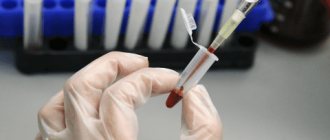What may affect the results
If the preparation rules are not followed, the results obtained may be incorrect. In addition, the accuracy of the study can be affected by acute inflammatory processes in the body (for example, ARVI, pneumonia, pyelonephritis, etc.) and chest injuries, so it is recommended to take a prolactin test no earlier than two weeks after recovery. Prolactin values may change due to the use of certain medications: for example, some psychotropic drugs (neuroleptics, antidepressants), hormonal, anticonvulsant, antitumor, certain antihypertensive drugs, some gastroenterological drugs and some others. It is necessary to inform the attending physician about their use and discuss the feasibility and possibility of cancellation before taking the test.
Prolactin - on what day of the cycle should women take it?
Before going for analysis, you need to know on what day of the cycle to take prolactin - this is crucial for the accuracy of the result:
- if you are prescribed a test for luteotropic prolactin (the first phase of the cycle), then it must be taken 5-8 days before the start of menstruation;
- When studying follicular blood, blood is taken on days 3-5 of the cycle.
The first day of the cycle is the day when spotting appears.
After receiving the results of the study, you must consult a doctor for interpretation and diagnosis, if required. Endocrinologist Georgy Nikitich Romanov has specialized in hormonal disorders in the body for many years and helps people restore health or return to a normal life. He not only provides paid appointments at the medical center, but also conducts online consultations in any way convenient for the client (Skype, VKontakte, Instagram, Viber, etc.).
Reference values
| Age | Prolactin level, honey/ml | |
| Men | Women | |
| 0-1 month | 78-1705 (in the neonatal period, an initially high level with a rapid decrease in the next 4-8 weeks) | 6.3-1995 (in newborns, the level is initially high with a rapid decrease over the next 4-8 weeks) |
| 1-12 months | < 607 | < 628 |
| Over 1 year old | 73-407 | 109-557 |
Elevated prolactin in women: symptoms
When prolactin is elevated, a complex of symptoms develops, the severity of which depends on how much the hormone level is higher than normal. Elevated prolactin in women can manifest itself as follows:
• Irregular menstruation – they become scanty and infrequent;
• High prolactin also provokes the release of milk from the mammary glands, which is called galactorrhea;
• Decreased libido and sexual activity;
• Enlargement of the mammary glands, the appearance of cysts in them, the development of mastopathy;
• Dryness of mucous membranes, vagina, skin;
• Long-term elevated prolactin in women leads to the development of bone fragility and a tendency to fractures, which is called osteoporosis.
What do lower numbers mean?
Prolactin, like some other hormones (ACTH, FSH, LH, TSH), is synthesized in the pituitary gland, which controls the functioning of the adrenal glands, ovaries, thyroid gland, mammary glands, and also regulates the growth and development of the body.
Various damage to the pituitary gland may be accompanied by a decrease in the level of prolactin and other hormones. Reduced levels of prolactin are observed in Sheehan syndrome (severe neuroendocrine pathologies that occur in women after abortions and complicated childbirth). In parallel, a decrease in the function of the thyroid gland, adrenal glands, and ovaries develops.
Impaired pituitary function (and correspondingly decreased prolactin levels) can be observed as a result of trauma, surgery and radiation therapy.
A slight decrease in the concentration of the hormone is detected with an increase in blood sugar levels - with diabetes mellitus, impaired glucose tolerance.
A decrease in prolactin is possible when taking certain medications: antiepileptics, dopaminergics, estrogens, dexamethasone, cyclosporine A, morphine, nifedipine, rifampicin.
When to take prolactin
A doctor may prescribe a blood test for prolactin based on the patient’s complaints and clinical picture.
Symptoms when prolactin should be taken for women and men can be:
- overweight;
- chest pain of any nature;
- sudden deterioration of vision;
- mood swings;
- increased headaches;
- identifying the cause and treatment of infertility;
- delayed sexual development.
For women, additional indications may include:
- discharge from the mammary glands and their groundless increase;
- menstrual cycle and ovulation disorders;
- severe menopause;
- low milk supply or feeding problems.

What do increased indicators mean?
The cause of increased prolactin is often various diseases of the hypothalamus and pituitary gland.
The hypothalamus is a section of the brain, a connecting link between the central nervous and endocrine systems, which, through the pituitary gland, controls the entire endocrine system of the body. An increase in prolactin can be associated with various endocrine diseases: decreased thyroid function, polycystic ovary syndrome, adrenal insufficiency.
Other possible reasons:
- severe diseases of internal organs (chronic renal failure, cirrhosis of the liver);
- tumors that produce estrogen;
- chest injuries;
- decreased sugar levels caused by insulin;
- shingles;
- taking certain medications (neuroleptics, estrogens and some others).
Prolactin (determination of macroprolactin with a prolactin result above 700 µIU/ml)
What is prolactin (mammotropin, luteotropic hormone, Prolactin)?
This is a polypeptide hormone synthesized by the cells of the anterior pituitary gland; a small amount of it is formed in peripheral tissues and in the endometrium of the uterus. During sleep, its level increases. After waking up, the concentration of prolactin decreases sharply, reaching a minimum in the late morning hours. After noon, the hormone level increases again. In the absence of stress, daily fluctuations in prolactin levels are within normal values. The secretion of prolactin is greatly influenced by the level of estrogen (high levels of estrogen stimulate the production of prolactin). Prolactin levels are elevated in the amniotic fluid and membranes of the fetus. Prolactin plays an important role in the formation of embryonic lung tissue. Newborns have relatively high prolactin levels, which decline over the first few months of life until they reach childhood levels. Hyperprolactinemia (increased levels of prolactin in the blood) is the main cause of infertility and dysfunction of the gonads in men and women. An increase in prolactin levels in the blood may be the first laboratory sign of pituitary dysfunction.
Functions of prolactin:
- stimulates the growth and development of mammary glands, milk formation (lactation process);
- during pregnancy, stimulates the production of progesterone by the corpus luteum of the ovaries;
- participates in the production of the hormone testosterone, stimulates the formation and development of sperm (in men);
- regulates water-salt metabolism, delaying the excretion of water and sodium by the kidneys;
- activates anabolic processes in the body, stimulates the development of internal organs, sebaceous glands, regulates fat metabolism;
- promotes the formation of sexual behavior;
- has a modulating effect on the immune system.
Indications for the purpose of analysis:
- galactorrhea;
- cyclical pain in the mammary gland;
- mastopathy;
- anovulation;
- oligomenorrhea, amenorrhea;
- dysfunctional uterine bleeding;
- infertility;
- diagnosis of sexual infantilism;
- diagnosis of chronic inflammation of the internal genital organs;
- comprehensive assessment of the functional state of the fetoplacental complex;
- differential diagnosis of true post-term pregnancy;
- disturbance of lactation in the postpartum period;
- severe menopause;
- obesity;
- hirsutism;
- decreased libido and potency (men);
- gynecomastia (men);
- osteoporosis.
Normally, prolactin is present in the blood in three forms: about 80% - in the form of a monomer (monoprolactin), this is the most active form of prolactin, 5-20% - in the form of a dimer (big prolactin), and about 0.5-5% - in form of a tetramer, is a complex of prolactin monomer and immunoglobulin G, called macroprolactin (big-big prolactin), this form is the largest (its molecular weight is about 200 kDa). A feature of macroprolactin is that it is cleared from the blood in a much longer time than forms of prolactin with a lower molecular weight. For this reason, macroprolactin has the ability to accumulate in the blood in high concentrations, creating a false impression of the level of prolactin secretion. Some healthy people have elevated prolactin levels precisely because most prolactin in the blood is in the form of macroprolactin. Macroprolactin is not active in the body, and often does not indicate the presence of a disease.
To reduce the likelihood of diagnostic and therapeutic errors when a high concentration of prolactin is detected in a patient, it is recommended to test for the presence of macroprolactin. Performing this test for hyperprolactinemia with a prolactin level of up to 700 μIU/ml is considered to be of little practicality, since it has been shown that in mild hyperprolactinemia, a significant presence of macroprolactin (more than 60% of the total amount) practically does not occur. If the result of the initial prolactin test is within the reference values, screening for macroprolactin has no practical significance.
Up to 26% of hyperprolactinemia detected during laboratory examination may be due to macroprolactinemia. At the same time, the proportion of macroprolactinemia among detected hyperprolactinemia depends on the method used to study prolactin, since different technologies for studying prolactin differ in sensitivity to macroprolactin. Therefore, prolactin test results obtained in different laboratories may vary significantly.
Method of determination Macroprolactin is determined using the precipitation of immune complexes with polyethylene glycol (PEG). If, after PEG precipitation, less than 40% of the initial prolactin level is determined in the blood serum, this indicates a high level of macroprolactin in the blood.
Indications for the purpose of the study:
- diagnosis of a form of hyperprolactinemia, especially when there are no specific symptoms with a significant increase in prolactin concentration.
- determining the need for treatment of patients with hyperprolactinemia, as well as to make a prognosis of the disease.
- establishing the cause of menstrual irregularities.
- diagnosis of female and male infertility.
When are prolactin levels elevated (hyperprolactinemia)?
- Physical or emotional stress.
- Thermal impact.
- Pregnancy.
- Lactation.
- Breast operations.
- Diseases of the hypothalamus (tumors, infiltrative diseases, arteriovenous defects, irradiation of the hypothalamic region, damage to the pituitary stalk).
- Diseases of the pituitary gland (prolactinoma, pituitary adenomas, empty sella syndrome, craniopharyngioma, intrasellar cyst, Rathke's pouch cyst, intrasellar germinoma, intrasellar meningioma).
- Hypofunction of the thyroid gland (primary hypothyroidism).
- Polycystic ovary syndrome.
- Chronic renal failure.
- Cirrhosis of the liver.
- Adrenal insufficiency and congenital adrenal dysfunction.
- Estrogen-producing tumors.
- Chest injuries.
- Ectopic secretion of hormones (lymphocytes, endometrium).
- Autoimmune diseases (systemic lupus erythematosus, rheumatoid arthritis, autoimmune thyroiditis, diffuse toxic goiter).
- Hypovitaminosis B6.
- Treatment with antihistamines (cimetidine, ranitidine), antipsychotics (neuroleptics, phenothiazine derivatives, molindone, loxapine, pimozine), taking carbidopa, estrogens, labetalol, metoclopramide, calcitonin, danazol, furosemide, peridol.
When is prolactin level low?
- Sheehan syndrome (pituitary apoplexy).
- True post-term pregnancy.
- Taking medications: anticonvulsants (carbamazepine, valproic acid, levodopa), dopaminergic drugs (bromocriptine, cabergoline, terguride, ropinerol), calcitonin, conjugated estrogens, cyclosporine A, dexamethasone, dopamine, apomorphine, metoclopramide, morphine, nifedipine, rifampicin, secretin , bombesin, tamoxifen.
Additional examination if the indicator deviates from the norm
Patients with prolactin levels that do not correspond to the norm are observed by an endocrinologist and gynecologist.
Not all cases of increased prolactin, especially if it is a slight increase, require therapy; sometimes dynamic observation is enough. A test for the presence of macroprolactin is carried out as an additional study when an increased level of porolactin (above 700 mU/l) is detected. Performing a test for macroprolactin does not increase the cost of determining the main indicator.
Macroprolactin is an inactive form of the hormone, therefore an increase in prolactin due to macroprolactin does not produce clinical manifestations and does not require additional examinations or drug therapy.
If prolactin levels change, a study of other pituitary hormones (ACTH, LH, FSH, TSH) may be additionally prescribed.
The hormone prolactin and women's health
The importance of maintaining normal levels of the hormone prolactin in women lies in several of its functions:
• prolactin in women supports the formation of milk by the glands during breastfeeding;
• stimulates the growth of lobules of glandular tissue in the mammary glands;
• prolactin inhibits ovulation during pregnancy and the onset of new menstruation;
• prevents early pregnancy after recent birth;
• prolactin reduces sensitivity to pain;
• participates in obtaining orgasm during sexual intercourse.
Complexes with this research
Advanced male anti-aging diagnostics Extended monitoring of key indicators in men aged 40+ 33,710 RUR Composition
Fitness monitoring Examination for choosing physical activity and monitoring the body's condition 6,780 RUR Composition
Preventive check-up Universal annual preventive screening RUB 11,960 Composition
IN OTHER COMPLEXES
- Male infertility. Extended examination RUB 29,030
- Fitness control of sports nutrition 5 140 RUR
- Male hormones RUR 6,180
- Female hormones. Follicular phase 5,930 R
- Anti-aging diagnostics. Hormonal balance RUB 6,250
Norm prolactin
86–324 µIU/ml are normal prolactin levels for men. In women, even non-pregnant women, this figure should be slightly higher – 102 – 496 µIU/ml. At the same time, hormone levels in women also depend on the phase of the menstrual cycle:
- follicular phase - 136–999 µIU/ml;
- ovulatory phase - 190–1484 µIU/ml;
- luteal phase - 148–1212 µIU/ml.
Prolactin levels also change during pregnancy: it increases with each trimester.
Hormones are the main regulators that ensure the vital functions of the entire body, including bearing a child.
Prolactin is produced by the anterior pituitary gland. During pregnancy, the active production of prolactin is promoted by another hormone - estrogen (its level also increases at this time).
The main task of prolactin is to start and maintain lactation. It also participates in the formation of the lung tissue of the unborn baby. At the very beginning of pregnancy, prolactin levels are not yet too high; their increase begins in the second trimester; in the third trimester, some women may even secrete colostrum from their nipples.
This hormone suppresses the functioning of the ovaries, so when breastfeeding, menstruation does not occur - it is usually absent for 6 months, then it is restored due to the weakening of prolactin.
What increases prolactin levels, based on the experience of traditional medicine?
- Raspberries. 4 tbsp. l. Steam the washed flowers and leaves of the plant in a thermos, pouring two glasses of boiling water. Let it brew for an hour, then take it regardless of food intake.
- Sage. Pour 100 g of dry raw material into 2 liters of boiling water, let it brew and take 100 ml three times a day.
- Oregano. To prepare the decoction, take 2 tablespoons of herbs and pour 300 ml. boiling water, let it brew. Take in small portions throughout the day, regardless of meals.
- Sweet clover. A decoction is prepared from this plant. You need to take a spoonful of dry raw materials, pour a glass of boiling water and cook in a water bath for a quarter of an hour. Then let it brew and take 50 g three times a day.
Do not forget that herbal mixtures, decoctions and infusions used in traditional medicine to normalize the level of prolactin in the blood can cause allergies. Therefore, if you have a tendency to atypical reactions of the immune system, you need to carry out treatment with folk remedies very carefully.
Prolactin: how to take it correctly
The period for taking the test is important only for non-pregnant women - they must donate blood on the 2-3rd day of the menstrual cycle. Before taking the tests, you need to familiarize yourself with simple recommendations:
- a day before the test, refrain from sexual contact and the effects of heat on the body (for example, visiting a sauna or steam bath);
- quit smoking within a few hours;
- 2 days before the test, do not eat heavy food or overeat;
- avoid nervous tension and stress - these conditions directly affect the level of the hormone (before entering the laboratory you need to calm down and relax as much as possible);
- exclude physical activity - on the day of delivery, refuse even light exercises;
- Blood sampling is carried out no earlier than three hours after waking up (this is due to the fact that during sleep the level of the hormone increases significantly);
- The last meal is allowed at least 8 hours before visiting the laboratory; you can only drink water.
PROLACTIN - WHAT IS IT?
Prolactin (PRL) is a hormone that primarily affects the functioning of the mammary glands. The main function of prolactin is to ensure normal lactation. Prolactin is considered a fertility hormone because its effect on the body is directly related to the ability to reproduce.
Prolactin is also called lactotropic, lactogenic, luteotropic, mammotropic hormone or mammotropin. In Latin, its name sounds like Prolactinum, in English Prolactin or Luteotropic hormone, in the literature you can find its abbreviations PRL and LTH. Prolactin is produced in a special place in the brain called the pituitary gland. The pituitary gland also produces many other hormones, such as thyroid-stimulating hormone, follicle-stimulating hormone, and growth hormone.
The amount of prolactin in the blood varies throughout the day because the pituitary gland produces prolactin irregularly. Before bedtime, in the evening and at night, the hormone content decreases significantly, and during sleep the hormone level increases progressively. The highest level of prolactin can be recorded in the morning, so it is recommended to take a blood test to determine the amount of this hormone a few hours after waking up.
Certain areas of cells in our body that can be affected by prolactin (prolactin receptors) are located in almost all organs. For example, receptors for this hormone can be found in the heart, lungs, liver and spleen, kidneys and adrenal glands, muscles and skin, brain and spinal cord, as well as in the male and female genital organs - the uterus, ovaries and testicles. Prolactin is considered essential for the normal regulation of the entire water-salt balance in the body; it helps to delay the release of fluid and various microelements by the kidneys.
It is important that the content of other sex hormones also depends on the amount of prolactin; for example, a significant increase in it in the blood helps to reduce the level of estrogen or testosterone.
Popular questions
Prolactin - 25.12.
What pills can you take to lower prolactin? If an increase in prolactin is detected for the first time, it is necessary to conduct further examination. Re-test the level of prolactin and macroprolactin, MRG of the pituitary gland to exclude or confirm prolactinoma. Treatment tactics and duration of therapy depend on the results. At this stage, you can start taking Gynocomfort Evening Primrose Oil, 2 capsules 2 times a day for up to 3 months, if the increase is physiological in nature.
Can hyperprolactinemia cause disruption of the vaginal microflora and cause burning and itching of the external genitalia? STI - negative, thrush - no. The smear shows either high leukocytes and cocci, just like I put on suppositories with lactobacilli, or a smear of rods and no leukocytes, but as soon as a couple of weeks have passed, it’s all over again. The itching and burning sensation from the candles does not go away.
Hello! If you have a menstrual cycle disorder, this can lead to changes in the mucous membranes of the genital tract. They become drier, more vulnerable, and lose elasticity. You need to correct your hormonal levels. To prevent inflammation, use Ginocomfort gel with mallow extract, which will eliminate dryness and help restore mucous membranes.
Prolactin was elevated, 1612, tested on the 3rd day of the cycle. Please advise me on medicine. The breasts are swollen, become very swollen before the cycle and there is an increase in body weight.
It is necessary to determine macroprolactin, which will allow us to understand what is causing the increase in prolactin: with prolactinoma or symptomatic due to taking a number of drugs, emotional stress, manifestations of endocrine disease, etc. Only determining the cause will help to correctly prescribe therapy.
Increased prolactin. I took it on the third day of cycle-576. TSH, FSH, LH, Estradiol - everything is normal. The doctor did not prescribe any other tests. Ultrasound of the pelvis is normal, ultrasound
mammary glands are normal, but one breast is more sensitive.
White discharge from the chest, a little. My periods began to come very little. The doctor first prescribed cyclodinone, then changed her mind and told me to take mastodinone for three months. What to do, because no one has named the reason for the increase in prolactin. Hello! In your case, we can recommend getting tested again for prolactin and macroprolactin. These hormones can be determined at any time during the cycle. This will help in diagnosis: functional increase or organic nature should be excluded. The recommended drug stabilizes functional disorders. It can be combined with Evening Primrose Oil, which is taken 2 capsules 2 times a day for 3 months. For an accurate diagnosis, contact a specialist








